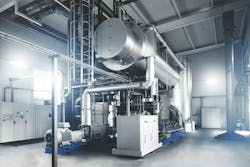Waste-heat recovery presents a significant opportunity for chemical plants in their quest to reduce carbon emissions. But many manufacturers struggle to recover low-temperature (or low-grade) waste heat. A process called the Organic Rankine Cycle (ORC) shows promise over conventional recovery methods for turning previously untapped low-grade heat into energy.
At its core, the ORC is a thermodynamic cycle that converts low-grade heat into electricity. Unlike traditional steam cycles, ORCs use organic fluids with lower boiling points, allowing them to harness low-grade heat from sources as low as 80°C [1].
Good thermal efficiencies for ORC systems can vary depending on the application and temperature range, but generally, efficiencies ranging from 8%-24% are considered good, with some specific systems achieving higher efficiencies under optimal conditions.
For example, when using certain refrigerants like R134a, facility operators have reported efficiencies of up to 8%, while high-temperature ORCs can reach efficiencies of up to 24%. This opens a world of possibilities for chemical plants, where waste heat is often left unrecovered.
Consider this: According to the Oak Ridge National Laboratory, the amount of low-grade waste heat (120°F reference) from the U.S. manufacturing sector is about 1,180 TBtu per year, which is approximately 53% of the unrecovered waste heat in industry [2].
That's an enormous amount of energy waiting to be harnessed, and ORC systems are the key to unlocking it. In the chemical industry, where energy costs can make up a significant portion of operating expenses, this represents a golden opportunity for cost reduction and improved sustainability.
Real-World Impact
Let's put this into perspective with some concrete numbers. In a study of ORC systems for waste heat recovery in the European Union, it was found that using only a portion of the available waste heat from industrial processes could generate around 150 TWh_e/a, corresponding to up to 5% of the total electricity production in the EU [3]. This staggering figure underscores the immense potential of ORC technology in industrial applications.
For chemical processing plants, implementing ORC systems can yield significant energy savings and reduced operating costs. Notable examples include polyester production sites, where ORC systems have successfully recovered energy from 120°C sources to produce 6.4 MWe of electricity while reducing carbon emissions [4]. Similarly, oil refineries can use ORC systems to capture waste heat from air leaving coolers at 140°C, achieving thermal efficiencies of over 11% [5].
Cutting-Edge Developments
The ORC field is rapidly evolving, with researchers pushing the boundaries of efficiency and applicability. Here are some exciting developments to watch:
- Supercritical CO2 Cycles: These cycles operate at higher pressures and temperatures, potentially achieving even greater efficiencies than traditional ORCs [6, 7]. For chemical plants dealing with high-temperature processes, supercritical CO2 cycles could offer a step-change in waste-heat recovery efficiency.
- Zeotropic Mixtures: By using carefully selected fluid mixtures, ORC systems can achieve power output increases of up to 50% at low-heat-source temperatures (100 to 140°C) [8, 9]. This is particularly relevant for chemical processes with multiple waste-heat streams at different temperatures, allowing for more flexible and efficient heat recovery.
- Advanced Control Systems: Model Predictive Control and artificial neural networks are being employed to optimize ORC performance in real time, adapting to fluctuating heat sources [10]. In the dynamic environment of a chemical plant, where heat availability can vary with production rates, these advanced control systems can ensure optimal ORC performance under all conditions.
- Compact Designs: Researchers are working on more compact ORC designs, which is crucial for retrofitting existing chemical plants where space is often at a premium. For instance, innovative heat exchanger designs and more efficient expanders are reducing the footprint of ORC systems without compromising performance.
Implementation Considerations
While the potential of ORC systems is clear, implementation requires careful planning. Here are key factors to consider:
- Heat Source Characteristics: Analyze your plant's waste heat streams, considering temperature, flow rate and variability. In chemical plants, this could include exhaust gases from furnaces, cooling water from reactors or even low-pressure steam that's currently vented to atmosphere.
- Working Fluid Selection: Choose a fluid that matches your heat-source temperature and complies with environmental regulations. New low-GWP (Global Warming Potential) fluids like hydrofluoroolefins are gaining traction [11]. The choice of working fluid can significantly impact system efficiency and environmental performance.
- System Integration: Consider how the ORC will integrate with existing processes. Look for opportunities to use the ORC's condenser for process heating, further increasing overall efficiency. In a chemical plant, this could mean preheating feed streams or providing low-grade heat for distillation columns.
- Economic Analysis: While ORC systems can offer significant savings, upfront costs can be substantial. A thorough economic analysis, including payback period calculation, is crucial. Consider not just energy savings but also potential benefits like reduced cooling water consumption and lower carbon emissions.
- Maintenance and Reliability: ORC systems, while generally low-maintenance, do require some upkeep. Ensure your plant has the capability to maintain the system or consider service agreements with ORC suppliers.
Case Study: Chemical Plant Application
To illustrate the potential of ORC in the chemical industry, let's consider a hypothetical case study. A midsize chemical plant produces 100,000 tons per year of a specialty chemical, with a distillation column rejecting 5 MW of heat at 95°C to cooling water. By implementing an ORC system, the plant could generate approximately 250 kW of electricity, equating to 2 million kWh per year. At an electricity price of $0.10/kWh, this represents $200,000 in annual savings. Moreover, the reduced demand for grid electricity cuts the plant's carbon footprint.
The Road Ahead
As the chemical industry continues to evolve toward a more sustainable future, ORC technology has emerged as a promising solution for improving energy efficiency. By harnessing waste heat and converting it into usable power, chemical processing plants can significantly reduce their energy consumption and lower their carbon footprint.
The potential benefits of ORC systems are enticing, with the ability to valorize the energy already on site and generate electricity as electrification demands and technologies are rapidly materializing. As research and development continue to advance, we can expect even more efficient and cost-effective ORC solutions to become available.
For chemical processors looking to stay ahead of the curve, embracing ORC technology can be a strategic move toward reducing energy costs and improving sustainability. Plants can not only reduce their environmental impact but also position themselves as leaders in the industry's transition towards more sustainable practices.
Is your plant ready to explore the potential of ORC technology and unlock the value of its waste heat?
References
- Woodland, B. J., Krishna, A., Groll, E. A., Braun, J. E., Horton, W. T., & Garimella, S. V. (2013). Thermodynamic Comparison of Organic Rankine Cycles Employing Liquid-Flooded Expansion or a Solution Circuit. Purdue e-Pubs CTRC Research Publications.
- Thekdi, A., Nimbalkar, S. U., Sundaramoorthy, S., Armstrong, K. O., Taylor, A., Gritton, J. E., ... & Cresko, J. (2021). Technology assessment on low-temperature waste heat recovery in industry (No. ORNL/TM-2021/2150). Oak Ridge National Laboratory (ORNL), Oak Ridge, TN (United States).
- Knowledge Center on Organic Rankine Cycle technology (KCORC). Thermal Energy Harvesting - The Path to Tapping into a Large CO2-free European Power Source: Version 1.0; 2022.
- (n.d.). TICA and Exergy showcase remarkable performance of ORC power plant at Sanfame Chemical Plant during on-site media tour. Retrieved from https://www.exergy-orc.com/tica-and-exergy-showcase-remarkable-performance-of-orc-power-plant-at-sanfame-chemical-plant-during-on-site-media-tour/
- Sadek, M. A., Gadalla, M. A., Shedid, N., Ahmed, D., & Elazab, H. A. (2023). Simulation and Optimization of Waste Heat to Electricity through Organic Rankine Cycles (ORCs): A Case Study in an Oil Refinery. Chemical Engineering Transactions, 98, 15-20. DOI: 10.3303/CET2398003
- Jeong WS, Lee JI, Jeong YH. Potential improvements of supercritical recompression CO2 Brayton cycle by mixing other gases for power conversion system of a SFR. Nuclear Engineering and Design 2011;241(6):2128–37.
- Crespi F, Arriba P de, Sánchez D, Muñoz A, Sánchez T. The potential of supercritical cycles based on CO2 mixtures in concentrated solar power plants: An exergy-based analysis. In: Proceedings of the 6th International Seminar on ORC Power Systems: Technical University of Munich; 2021.
- Braimakis K, Mikelis A, Charalampidis A, Karellas S. Exergetic performance of CO2 and ultra-low GWP refrigerant mixtures as working fluids in ORC for waste heat recovery. Energy 2020;203:117801.
- Braimakis K. Multi-scale thermo-economic optimization and thermodynamic assessment of energetic and exergetic efficiency improvement concepts of organic rankine cycle 2018.
- Pili R, Wieland C, Spliethoff H, Haglind F. Model predictive control for organic Rankine cycle systems on heavy-duty trucks: controller tuning and optimization. In: Proceedings of the 6th International Seminar on ORC Power Systems: Technical University of Munich; 2021.
- Dawo F, Fleischmann J, Kaufmann F, Schifflechner C, Eyerer S, Wieland C et al. R1224yd(Z), R1233zd(E) and R1336mzz(Z) as replacements for R245fa: Experimental performance, interaction with lubricants and environmental impact. Applied Energy 2021;288:116661.
About the Author
Thomas Kwan
Global Vice President, Strategic Innovation and Industrial Ecosystems
Thomas Alan Kwan is an energy transition expert at Schneider Electric's Sustainability Research Institute. With a Ph.D. in chemical and environmental engineering, he brings a blend of academic rigor and industrial experience to the field of sustainable manufacturing and green engineering.
At Schneider Electric, he leads initiatives focused on new and emerging industrial systems, with a particular emphasis on the chemical processing sector. His work involves developing innovative solutions and practices to drive energy, environmental and economic benefits.
Previously, he was a key member of Unilever's product engineering team, where he integrated green chemistry and engineering principles for product and process development. His contributions earned him a lifetime honorary membership on the team. Kwan also has experience in environmental regulation, having worked with the U.S. EPA on Clean Water Act programs.
Through his research and collaborations, Kwan continues to explore innovative ways to reduce energy consumption, minimize waste, maximize value and improve overall process efficiency in chemical manufacturing operations.

